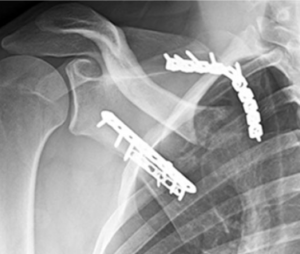Scapula (Shoulder Blade) Fracture
What is a Scapula Fracture?
A scapula fracture is a broken shoulder blade. This is the triangular bone at the back of the shoulder. This usually results from high energy trauma such as a car accident. The bone can break in just one spot or multiple parts. Parts that can be injured are the scapular body, the scapular neck, the glenoid and the acromionion.
What does the Scapula do?
The scapula is a large flat bone that forms one half of the shoulder joint (the glenoid). It also provides motion and stability for the arm by attaching the upper extremity to the chest wall. There are 18 muscles that attach to the scapula.
Diagnosis and Examination
Physical examination is important in the evaluation of these injuries. Important blood vessels and nerves lie underneath the collarbone and can be injured when it breaks. One extremely severe injury (scapulothoracic dissociation) occurs when the shoulder blade is pulled so hard that it is disconnected from the chest wall. This often results in loss of nerve function to the arm and hand and injury to blood vessels. A thorough exam is crucial in early diagnosis. The doctor will also look for any open wounds over the injury.
X-rays are used to evaluate the location, type, and severity of the broken bone. This helps doctors and patients make an informed decision on treatment. Often two or more x-rays are taken in the standing position to show the injury pattern. CT scans are recommended at times if more detail is required to determine need for operative fixation.
Non-Surgical Treatment for Scapula Fractures
Most scapula fractures do not require surgery. Many heal just fine without an operation. Minor fractures with minimal displacement do very well with nonsurgical treatment. Science has shown that there is no difference in use of a sling, shoulder immobilizer or figure-of-eight brace. These devices are used for support and comfort only.
If non-operative care is chosen, regular follow-up care for a physical exam and x-rays is important to ensure that the fracture stays in good position and heals appropriately. Cutting down or quitting smoking and tight blood sugar control if you are a diabetic is important for the healing process. Early motion is helpful in keeping patients from getting stiff and losing motion
Surgical Treatment for Scapula Fractures
Surgeons may recommend an operation to fix the broken scapula if the glenoid or scapular neck is injured. In addition, if the clavicle is also fractured, either the clavicle, scapula or both can require operative fixation.
The scapula can be fixed with plates and screws. These require large incisions over the back of the shoulder blade or in the arm pit. Surgery can take several hours. Ideally, surgeons like to perform this surgery within 1-2 weeks of injury. Thus, patients have time to seek a second opinion regarding treatment if more information or additional surgeon input is desired.
It is important to choose your surgeon wisely. The lung and several important blood vessels and nerves lie underneath the scapula. It is possible for these to be injured during surgery. Extensive surgical experience can be helpful in achieving a good result and avoiding complications. Collectively, ROC orthopedic surgeons have performed more scapula operations than any practice in Northern Nevada and take pride in outstanding surgical results.
After surgery, patients are allowed to use their arm for gentle activities and a sling for comfort only. Weight-bearing is limited to a few pounds overhead. Initial range-of-motion exercises are encouraged.

Postoperative x-ray of of scapula fracture repair.
Surgical Complications
Complications can occur with any surgery, no matter how small. There is always a risk of infection. A dose of antibiotics given prior to surgery helps to make this risk as small as possible. There is always a risk of injury to blood vessels or nerves. This is reduced by having an experienced surgeon involved in your care. The lung also lies close to the scapula, and it is possible to create an injury to the lung during surgery. Patients are observed closely in the recovery room after surgery before going home. If any breathing problems arise after surgery, patients are instructed to go immediately to the closest hospital emergency room. Finally, it is always possible that the bone may not heal. This is usually associated with patient non-compliance, diabetes, or use of nicotine like smoking and chewing tobacco.
Outcomes
Most people with scapula fractures do very well. By six weeks, patients are extremely comfortable and usually are released to full activities such as manual labor, skiing and motocross by three months. Aggressive return to activity too early can result in re-fracture, hardware breakage or non-union.
